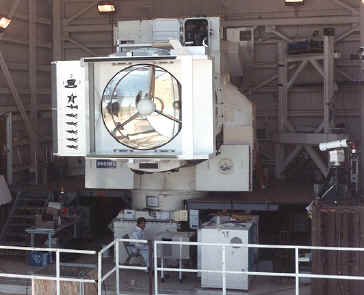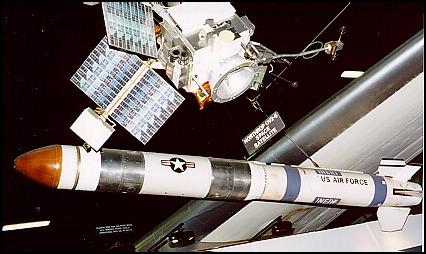- The U.S. Congress banned anti-satellite weapons testing for ten years in 1985, fearing it may spark an arms race. After this ban expired, the U.S. Army gained approval for testing from President Clinton in order to "develop countermeasures" in case American satellites are targeted. On October 21, 1997 the U.S. military tested an anti-satellite laser called the Mid-Infrared Advanced Chemical Laser (MIACL). This TRW laser (below) has been around since the 1980s, a left over from Reagan's "Star Wars" research programs.
 Test laser shots were fired at unused U.S. Air Force satellite 260 miles
above Earth. The satellite was not destroyed, but the Army was more interested
in testing the vulnerability of delicate satellite sensors. Huge ground
based lasers probably cannot burn up anything in space because most all of the
laser beam is scattered as it passes through the Earth's atmosphere.
Nevertheless, blinding a reconnaissance satellite effectively destroys it.
Test laser shots were fired at unused U.S. Air Force satellite 260 miles
above Earth. The satellite was not destroyed, but the Army was more interested
in testing the vulnerability of delicate satellite sensors. Huge ground
based lasers probably cannot burn up anything in space because most all of the
laser beam is scattered as it passes through the Earth's atmosphere.
Nevertheless, blinding a reconnaissance satellite effectively destroys it.
In the left photograph, notice the small images
painted on the laser housing. The U.S. military has a tradition of painting images
of aircraft which a system shot down. Apparently, MIACL has already
downed five aircraft drones and a missile, plus a star and a top hat? Huge
lasers would be prime targets in a major war, so they need to be mobile.
MIACL is far too large to move on trucks, but river barges would provide an
ideal platform. 
On the other hand, it's probably more cost effective to use air-to-space missiles like the U.S. Air Force ASAT (right). This large missile was successfully tested from an F-15 in 1985, and destroyed a satellite in low orbit. The U.S. Army is developing a surface-to-space anti-satellite missile, but tests have not been conducted.
Since satellites often just stop functioning, a mischievous nation could occasionally zap an expensive satellite with a laser, and the owner could not know what caused it to fail. Countermeasures may prove impossible because a laser light travels at the speed of light, so advance warning of an incoming beam is impossible. This is an important area which will remain mostly secret. In December 2000, UPI published an article revealing that the U.S. and the Soviet Union have already fought in space. Read Space War.
Carlton Meyer editorG2mil@Gmail.com